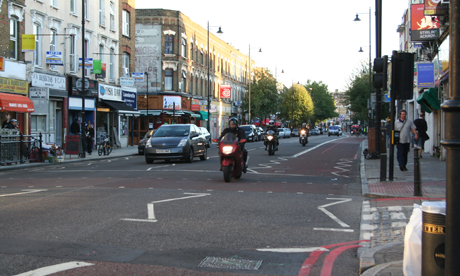The only way is two-way in Stoke Newington

No two ways about it: Stoke Newington High Street at present. Photo: Hackney Council
We are delighted that Hackney Council is consulting on the future of Stoke Newington’s streets. Transport for London (TfL) and the Mayor of London control the A10 [which includes Stoke Newington High Street], and they won’t budge unless there’s an unequivocal demand for two-way from the borough.
Scrapping the gyratory is a longstanding aspiration for many residents, visitors and traders. To them, the advantages of returning to two-way are clear, and a few months’ disruption while the changes are made will be a price well worth paying in exchange for people-friendly streets.
Others, though, are understandably concerned about the cost and timescale of this change, and are thinking of ways in which the negative effects of the current system might be reduced while keeping it one-way.
Our view is that there’s no future in tinkering with a broken set-up.
The problems which we all currently have to put up with – fast motor traffic, reduced crossing opportunities, ratrunning, and diverted journeys – are a direct result of the streets being one-way, and will be difficult or impossible to fix while the streets stay one-way.
Let’s look at each of these issues in turn.
First, speed. Multi-lane one-way streets inevitably result in higher motor traffic speeds. Give people a race-track, and they will race. Twoway working, with the expectation of traffic in the other direction, and little chance of overtaking, causes people to moderate their speed naturally, reducing the need for technical fixes such as cameras and humps.
The non-High Street sections of the current gyratory in particular suffer from inappropriately high speeds, as people put their feet down to get around the tedious southbound diversion as quickly as possible. A two-way High Street will see lower speeds, while Northwold Road, Rectory Road, Manse Road and Evering Road will be returned to borough control, allowing them all to be included in the council’s commitment to 20mph as the default speed limit.
Second, crossing the street. We will campaign with residents for as many pedestrian crossings as possible, both on a two-way High Street, under TfL control, and on the three-quarters of a mile of streets which will be returned to borough control. On the latter, we would like to see frequent zebra crossings, because these give the maximum degree of priority to pedestrians, and work well on two-way streets where speeds are low. On the High Street, TfL will probably insist on signal-controlled crossings, and we would push for a good distribution of these, together with allgreen pedestrian phases and diagonal crossings at junctions. Even away from formal crossing facilities, it will be much easier to cross due to the reduced speed of motor traffic all round.
Third, rat-running. We advocate widespread ‘filtering’ of residential streets, which will allow residents’ cars and service vehicles to reach every address, and return to the main streets the same way. This is the most effective way of eliminating through motor traffic and creating peaceful, low-speed streets. Look south to De Beauvoir for a well established example of this technique (and home-owners, check out their house values!). But filtering the minor streets while keeping the main streets one-way would result in long diversions around the one-way system for residents and deliveries. Filtering is only really viable if the main streets are two-way.
Last but not least, diverted journeys. The current one-way system inconveniences everyone, but its worst effects are on bus journeys and on cycling. Currently, people using buses (the majority of trips in our borough) are forced to walk to remote stops, inconveniencing residents and discouraging people from coming to the High Street to shop. Down in Shoreditch, where a similarly outdated one-way system was scrapped in 2002, bus journeys are now far more straightforward, and the effect on retail custom has been dramatic. Bus priority measures were also introduced at the approaches to the town centre – something Stoke Newington could benefit from too.
Cycling, meanwhile, is massively suppressed by the gyratory system, which makes journeys longer, more hazardous and downright confusing to navigate. Following the return of Shoreditch’s main streets to two-way in 2002, there has been a cycling renaissance, with people on bikes now making up more than half of the vehicular traffic flow through some junctions on Old Street in the morning peak. Stoke Newington can have that too – though not via contra-flow cycle tracks, which simply can’t offer the required level of service, and have disadvantages for pedestrians and deliveries.
We encourage everyone to respond to Hackney Council’s consultation survey. Be aware that the most important questions come near the end of the survey, especially question 20, which asks: “Would you support the removal of the current one-way traffic system if it is replaced with two way traffic flows on Stoke Newington High Street, Northwold Road, Rectory Road and Evering/ Manse Road?”
We would like you to answer YES to this, please! Anything else is a fudge, and won’t get Stoke Newington the more people-friendly streets we deserve.
To have your say, see Hackney Council’s Stoke Newington gyratory consultation
